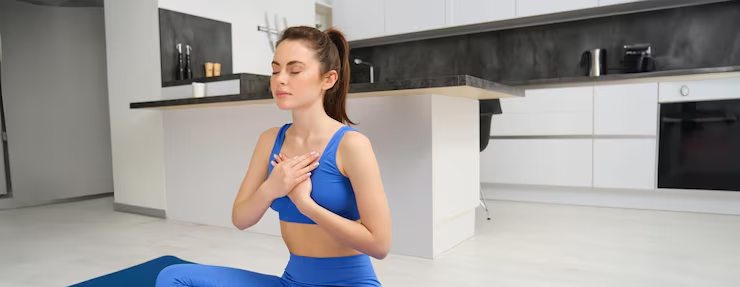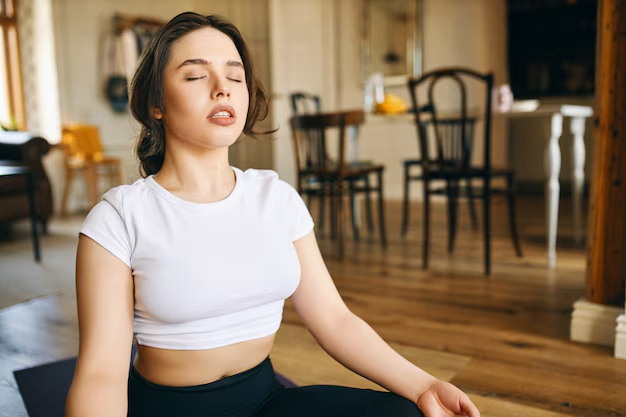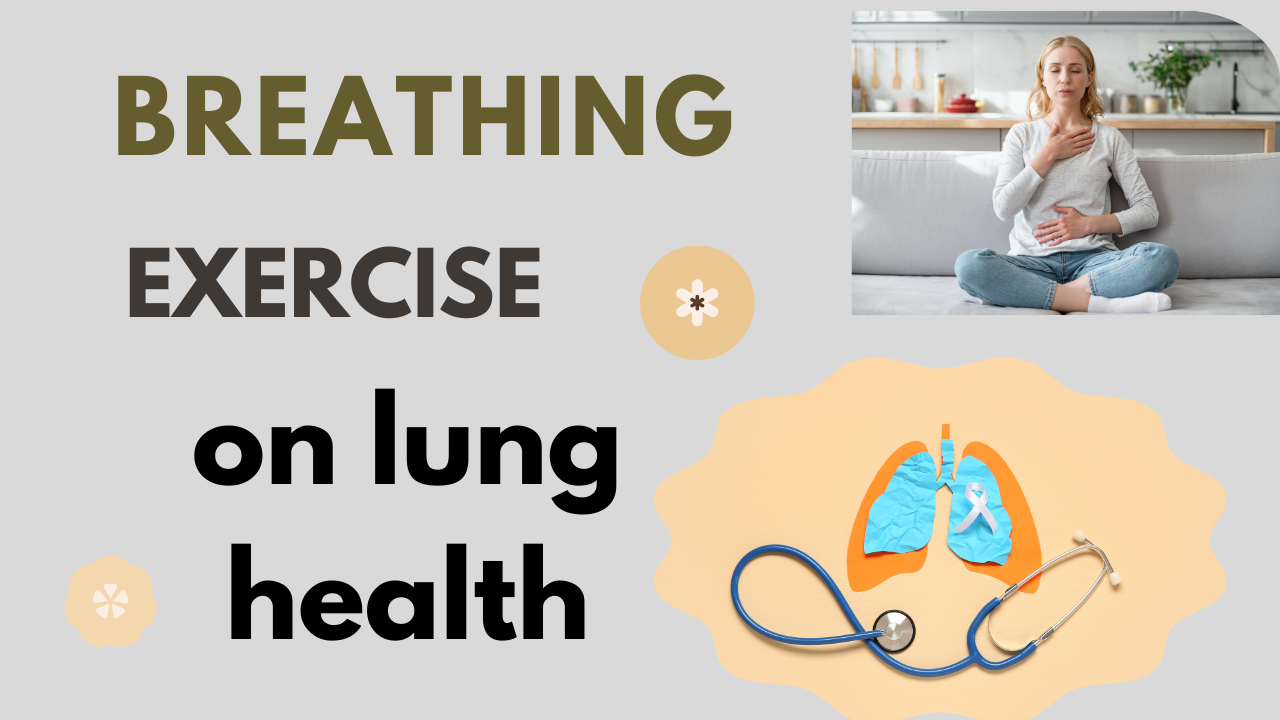Breathing is the most natural action we perform, yet many of us underestimate its role in overall health. The lungs are vital organs that supply oxygen and remove carbon dioxide, keeping every cell alive and energized. Unfortunately, pollution, smoking, sedentary lifestyles, and stress often weaken lung function. This is why practicing breathing exercises for lung health is more important than ever.
Unlike medications or temporary treatments, breathing exercises are holistic, natural, and safe. They not only strengthen respiratory muscles but also improve oxygen intake, cleanse toxins, and boost energy levels. Whether you’re young or old, healthy or struggling with respiratory issues, these techniques can make a remarkable difference in your daily life.
This article explores the top 8 breathing exercises for lung health, along with their benefits, techniques, and tips for practice. You’ll also learn what they are, why they’re important, when and where to do them, how they work, and answers to frequently asked questions.

What Are Breathing Exercises for Lung Health ?
Breathing exercises for lung health are structured techniques designed to train the respiratory system to work more effectively. These practices focus on improving airflow, expanding lung capacity, and strengthening the diaphragm along with the intercostal muscles that support breathing. Unlike shallow breathing, which limits oxygen intake, these exercises encourage deep, slow, and mindful inhalation and exhalation for optimal lung performance.
They are widely practiced in yoga, meditation, physiotherapy, and respiratory therapy, where they play a key role in preventing lung damage and boosting overall wellness. Regular practice helps clear mucus from the airways, reduce inflammation, ease stress, and promote efficient oxygen circulation throughout the body.
By making breathing exercises for lung health a part of your daily routine, you can naturally support stronger lungs, better immunity, and higher energy levels. Over time, these simple yet powerful techniques enhance both respiratory function and mental clarity, contributing to long-term well-being.
Why Are Breathing Exercises Important for Lung Health ?
Practicing breathing exercises for lung health is essential because our lungs gradually lose elasticity due to aging, pollution, or unhealthy lifestyle habits. This decline reduces oxygen intake and makes simple activities like walking or climbing stairs feel exhausting. Breathing techniques help counteract this effect by strengthening respiratory muscles, expanding lung capacity, and improving overall resilience.
These exercises are particularly beneficial for individuals managing asthma, COPD, anxiety, or recovering from smoking-related damage. By focusing on deep, controlled breathing, the lungs are better able to exchange oxygen and carbon dioxide efficiently, which enhances energy levels and promotes healing.
Beyond physical benefits, breathing exercises for lung health also provide mental wellness advantages. They calm the nervous system, lower stress hormones, and boost mental clarity. In short, these practices not only protect and restore lung function but also support emotional well-being, making them one of the most effective natural remedies for respiratory health.
Improve Lung Capacity: Regular practice helps expand lung volume.
Reduce Stress & Anxiety: Controlled breathing lowers cortisol and blood pressure.
Aid in Detoxification: Helps expel carbon dioxide and toxins from lungs.
Support Recovery: Beneficial for asthma, COPD, and post-COVID-19 recovery.
Boost Oxygen Supply: Enhances oxygen delivery to muscles and brain.
When Should You Practice Breathing Exercises ?
The best time to practice breathing exercises for lung health is early morning, when the air is fresh and pollution levels are lower. However, they can be performed at any time of the day, depending on your routine.
If you experience stress, anxiety, or shortness of breath during the day, practicing a few minutes of deep breathing can provide immediate relief. Similarly, before bedtime, these exercises help relax the body and prepare you for restful sleep.
Consistency is the key. Practicing daily, even for just 10–15 minutes, ensures long-term benefits for your lungs and overall wellness.
Early morning in fresh air
Before or after workouts
During stress or anxiety episodes
Post-illness recovery (with doctor’s advice)
Where Can You Do Breathing Exercises ?
One of the best things about breathing exercises for lung health is that they can be practiced anywhere. You don’t need special equipment or a gym membership.
You can practice them in your bedroom, at your office desk, during yoga sessions, or while sitting in a park. Outdoor practice, especially in clean, natural environments, is highly recommended because fresh air enhances the effectiveness of these exercises.
As long as the surroundings are calm, clean, and distraction-free, you can easily integrate these exercises into your lifestyle.
At home (quiet, ventilated space)
Outdoors (parks, gardens, beaches)
Yoga/meditation centers
Even at work (desk-friendly breathing drills)
How Do Breathing Exercises Work ?
Breathing exercises for lung health work by strengthening the diaphragm, enhancing airflow, and improving oxygen exchange within the lungs. Through controlled inhalation and exhalation, the respiratory muscles gain strength, while the lungs gradually regain elasticity, allowing them to expand and contract more effectively.
Practicing deep breathing techniques also helps clear toxins and pollutants from the airways, reduces mucus buildup, and ensures that oxygen is delivered more efficiently to the body’s tissues and cells. In addition to physical benefits, these exercises stimulate the parasympathetic nervous system, which calms the mind, reduces stress hormones, and promotes overall relaxation and mental clarity.
When practiced consistently, breathing exercises train your body to adopt healthier breathing patterns, making every breath more efficient. This not only supports long-term lung function but also prevents respiratory complications, boosts energy, and strengthens the immune system—offering a natural, powerful way to protect and enhance lung health.
Top Breathing Exercises for Lung Health
Diaphragmatic Breathing (Belly Breathing)

Diaphragmatic breathing is one of the most effective breathing exercises for lung health. It focuses on strengthening the diaphragm, the main muscle of respiration. This technique helps people breathe deeper, improving oxygen intake and reducing stress.
To practice, sit or lie down comfortably. Place one hand on your chest and the other on your stomach. Breathe in deeply through your nose, letting your stomach rise as the diaphragm pulls air into the lungs. Exhale slowly through pursed lips, feeling your stomach fall.
This exercise improves lung efficiency and is especially useful for people with COPD, asthma, or shallow breathing habits. Practicing for 5–10 minutes daily ensures stronger lungs and better control over breathing.
How to Do It: Sit or lie down, place one hand on your chest and the other on your belly. Inhale deeply through your nose, letting your belly rise. Exhale slowly through pursed lips.
Benefits:
Strengthens diaphragm
Improves oxygen intake
Reduces stress and anxiety
Helps COPD and asthma patients
Prevents shallow breathing habits
Ingredients (Requirements):
Quiet space
Comfortable chair, bed, or yoga mat
Loose clothing for easy breathing
Pursed-Lip Breathing
Pursed-lip breathing is a simple yet highly effective technique that helps regulate breathing and improve airflow to the lungs. This method is especially recommended for individuals who often feel short of breath, such as those with asthma, COPD, or recovering from smoking-related lung damage.
To perform the exercise, start by inhaling slowly and deeply through your nose. Then exhale gently through pursed lips, as if you were blowing out a candle or whistling. The key is to make your exhalation twice as long as your inhalation. By doing so, the airways remain open longer, preventing their collapse and allowing stale air to be expelled more efficiently.
Beyond its respiratory benefits, pursed-lip breathing also promotes relaxation, calms anxiety, and improves oxygen exchange in the body. When practiced regularly, it can reduce breathlessness during physical activity, support lung function, and provide a natural way to strengthen overall respiratory health.
How to Do It: Inhale through your nose for 2 seconds, then exhale slowly through pursed lips for 4–6 seconds.
Benefits:
Slows breathing rate
Prevents airway collapse
Improves oxygen-carbon dioxide exchange
Reduces shortness of breath
Promotes relaxation
Ingredients (Requirements):
Calm sitting position
Fresh air environment
Can be practiced anywhere, even while walking
Kapalabhati (Skull Shining Breath)

Kapalabhati, also known as the “skull-shining breath,” is a powerful yogic breathing technique that acts as a natural detox method for the lungs. It involves a series of forceful exhalations followed by passive inhalations, which helps cleanse the respiratory tract and expel toxins effectively. Practicing Kapalabhati not only improves lung function but also energizes the entire body.
To perform the exercise, sit in a comfortable position with your spine straight. Inhale normally, then exhale forcefully through your nose while simultaneously pulling your abdominal muscles inward. The inhalation that follows occurs naturally, without effort. This cycle can be repeated rapidly for 20–30 rounds, with a short rest before beginning another set.
Kapalabhati strengthens respiratory muscles, increases lung capacity, improves digestion, and sharpens mental clarity. However, it is not recommended for individuals with high blood pressure, heart disease, or certain respiratory conditions. Practiced safely, it is an excellent technique for long-term lung health.
How to Do It: Sit straight, inhale deeply, then forcefully exhale through the nose while pulling the stomach in. Do 20–30 rounds.
Benefits:
Detoxifies lungs and clears mucus
Boosts lung capacity
Energizes body and mind
Improves digestion and circulation
Increases mental clarity
Ingredients (Requirements):
Quiet yoga space
Empty stomach (best done in morning)
Cushion or yoga mat for sitting comfortably
Anulom-Vilom (Alternate Nostril Breathing)
Anulom-Vilom is a balancing practice that calms the mind and strengthens the lungs. It is among the most effective yogic breathing exercises for lung health.
To perform it, sit in a relaxed position. Close your right nostril with your thumb, inhale through the left nostril, then close the left nostril with your ring finger and exhale through the right nostril. Continue the cycle, alternating nostrils.
This practice balances oxygen flow, reduces stress, and improves lung efficiency. Daily practice enhances both physical and mental wellness, making it ideal for overall respiratory health.
Benefits:
Balances oxygen flow
Relieves stress and anxiety
Improves lung efficiency
Enhances concentration
Boosts immunity and respiratory strength
Ingredients (Requirements):
Calm sitting posture
Clean environment with fresh air
Yoga mat or cushion for comfort
Bhramari (Bee Breathing)
Bhramari involves producing a humming sound while exhaling, which calms the mind and improves breathing. It is one of the most relaxing breathing exercises for lung health.
To practice, sit comfortably, close your eyes, and take a deep breath in. While exhaling, press your fingers lightly on your ears and make a humming “mmm” sound. Feel the vibrations in your chest and throat.
This exercise relieves stress, improves airflow, and supports lung function. Practicing for 5 minutes daily enhances concentration and promotes emotional well-being.
Benefits:
Reduces stress and anger
Improves airflow in lungs
Enhances concentration and focus
Calms nervous system
Supports lung function
Ingredients (Requirements):
Quiet, calm environment
Yoga mat or chair
Best practiced during morning or before sleep
Box Breathing (Four-Square Breathing)
Box breathing is a controlled technique often used by athletes and even military personnel to improve focus and lung strength. It is one of the best breathing exercises for lung health and mental clarity.
To practice, inhale for 4 seconds, hold your breath for 4 seconds, exhale for 4 seconds, and hold again for 4 seconds. Repeat the cycle 5–10 times.
This method improves oxygen flow, reduces stress, and trains the lungs for better endurance. It is particularly useful during stressful situations or before sleep.
How to Do It: Inhale for 4 counts, hold for 4 counts, exhale for 4 counts, hold again for 4 counts. Repeat 5–10 times.
Benefits:
Increases lung endurance
Enhances oxygen flow
Reduces anxiety and stress
Improves focus and clarity
Helps regulate breathing rhythm
Ingredients (Requirements):
Calm space (can be done at work or home)
Timer/clock for count (optional)
Comfortable sitting posture
Buteyko Breathing

The Buteyko method focuses on shallow breathing to normalize breathing patterns and reduce hyperventilation. It is an advanced form of breathing exercises for lung health.
To practice, sit comfortably and take a small, gentle breath in and out through the nose. Then hold your breath for a few seconds before breathing normally again. Repeat several cycles.
This technique helps people with asthma and anxiety by reducing over-breathing and restoring oxygen balance in the body. It requires practice and should be learned gradually.
Benefits:
Reduces hyperventilation
Restores oxygen balance
Helps asthma and anxiety patients
Improves breathing efficiency
Supports cardiovascular health
Ingredients (Requirements):
Quiet room
Comfortable sitting arrangement
Calm, distraction-free environment
Deep Breathing with Stretching
Combining deep breathing with physical stretches is one of the simplest breathing exercises for lung health. It expands lung capacity while improving flexibility and circulation.
To practice, stand tall, raise your arms slowly while inhaling deeply, then lower your arms as you exhale. Repeat the stretch several times while maintaining slow, steady breaths.
This exercise enhances posture, prevents stiffness, and improves oxygen delivery. It is especially beneficial for office workers or people with sedentary lifestyles.
How to Do It: Stand straight, extend arms sideways while inhaling deeply. Bring arms down while exhaling slowly
Benefits:
Expands lung capacity
Improves posture and circulation
Relieves stiffness in muscles
Enhances oxygen delivery to cells
Boosts energy levels
Ingredients (Requirements):
Open space with room to stretch
Comfortable clothing
Yoga mat (optional)
Scientific Benefits of Breathing Exercises
Breathing exercises are more than relaxation techniques—they are backed by science. Studies show that consistent practice:
Enhances lung capacity by strengthening respiratory muscles.
Improves oxygen delivery to the brain and body tissues.
Reduces stress and cortisol levels, which indirectly benefits respiratory health.
Helps people with asthma, COPD, and bronchitis manage symptoms better.
When practiced regularly, these techniques can also improve sleep quality, reduce fatigue, and enhance focus.
Lifestyle Support for Healthy Lungs
Breathing exercises work best when combined with a lung-friendly lifestyle:
Quit smoking – removes toxins damaging lung tissues.
Stay active – walking, swimming, and yoga amplify breathing benefits.
Eat anti-inflammatory foods – turmeric, ginger, garlic, and leafy greens.
Stay hydrated – thin mucus is easier to expel.
Limit pollution exposure – use indoor plants and air purifiers
Sample Daily Routine (20 Minutes for Lung Health)
| Time | Activity | Duration |
|---|---|---|
| 6:30 AM | Deep Diaphragmatic Breathing | 3 min |
| 6:35 AM | Anulom-Vilom (Alternate Nostril) | 5 min |
| 6:40 AM | Kapalabhati (Cleansing Breath) | 5 min |
| 6:45 AM | Bhramari (Humming Bee Breath) | 3 min |
| 6:50 AM | Relaxation & Normal Breathing | 4 min |
Conclusion

Caring for your lungs should be a lifelong priority. Practicing breathing exercises for lung health is one of the most effective and natural ways to strengthen respiratory function. These techniques improve lung capacity, clear toxins, reduce stress, and enhance overall vitality.
The beauty of these exercises lies in their simplicity and accessibility. They can be performed anywhere—at home, outdoors, or even at work. Whether you choose diaphragmatic breathing, alternate nostril breathing, or yoga-inspired techniques, consistency will bring long-lasting results.
By integrating these practices into your daily routine, you not only improve your lungs but also your overall quality of life. Start today with just a few minutes, and over time, these powerful breathing exercises for lung health will transform your energy, immunity, and well-being.
FAQs
Q1. What are the best breathing exercises for lung health ?
The best ones include diaphragmatic breathing, pursed-lip breathing, Anulom-Vilom, Kapalabhati, and box breathing. These strengthen the lungs naturally.
Q2. Why are breathing exercises important for the lungs ?
They increase lung capacity, improve oxygen flow, clear mucus, and reduce stress. They also prevent long-term respiratory problems.
Q3. When should I practice breathing exercises ?
Morning is ideal due to fresh air, but they can be done anytime—during stress, before bed, or whenever you feel short of breath.
Q4. Where can I do breathing exercises for lung health ?
They can be practiced anywhere—at home, in a park, at your desk, or during yoga. Clean, quiet environments are best.
Q5. How do breathing exercises actually improve lung health ?
They strengthen respiratory muscles, increase oxygen exchange, clear toxins, and train the lungs to function more efficiently.


